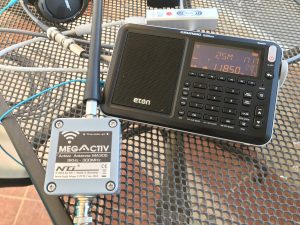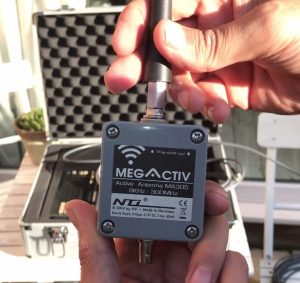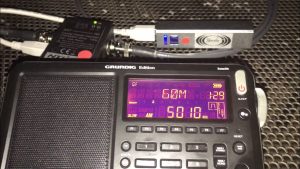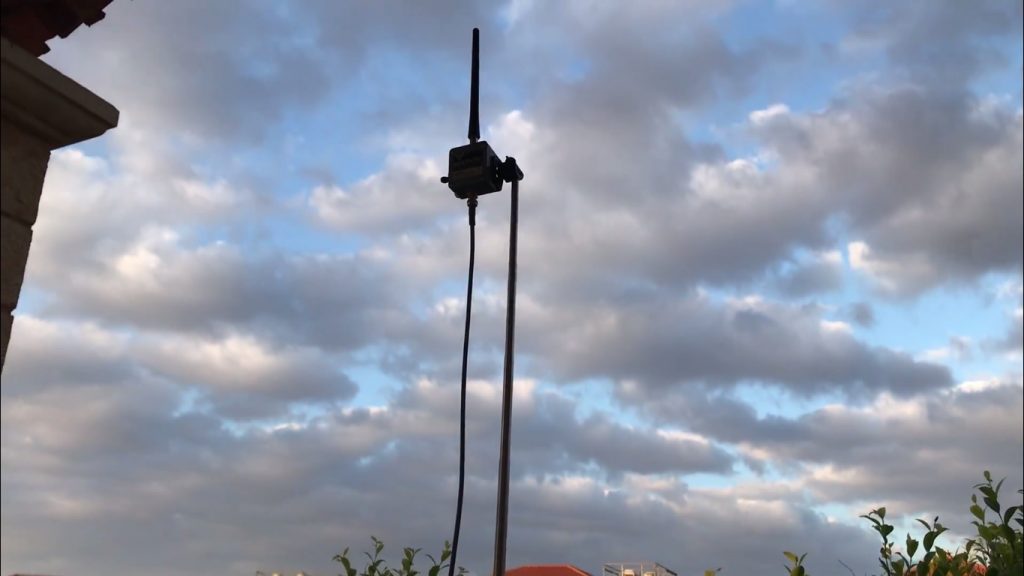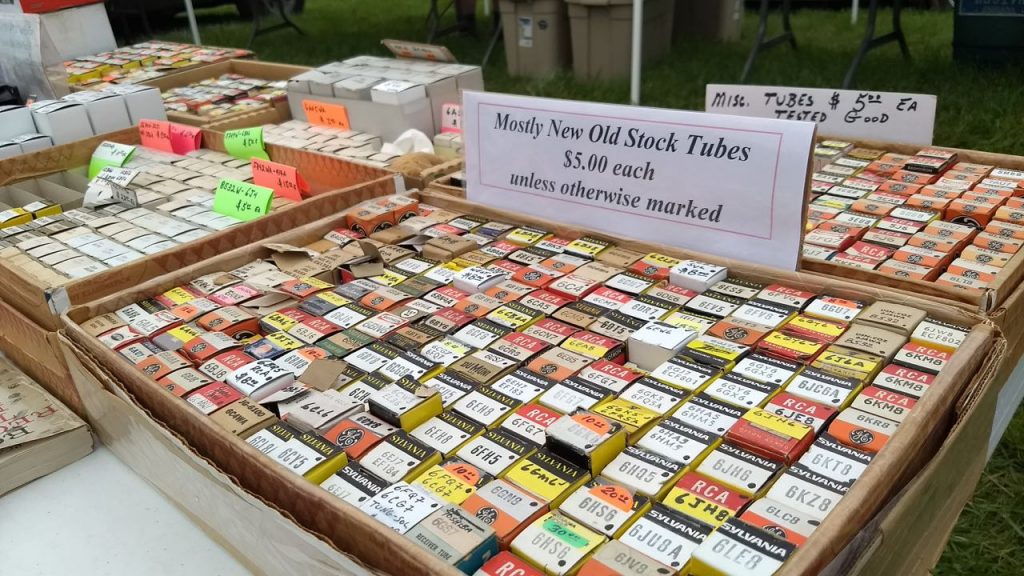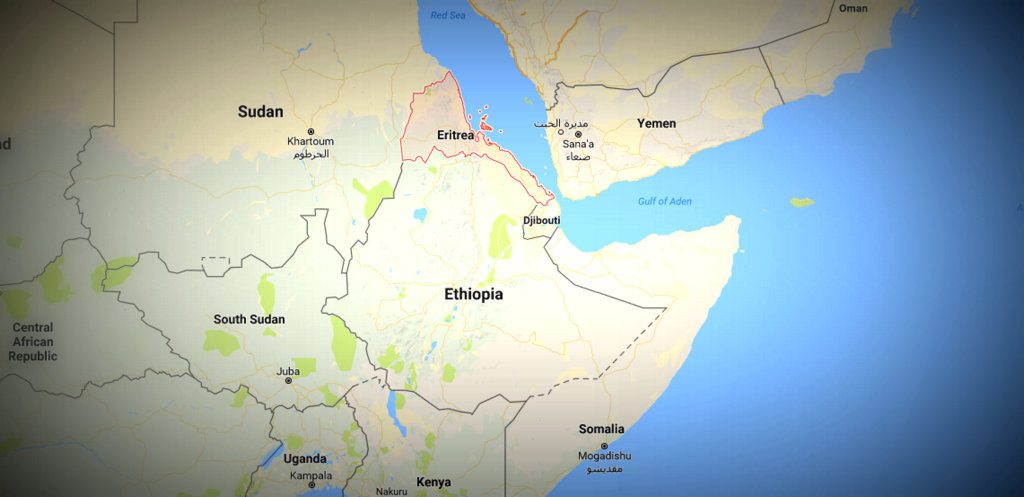Many thanks to SWLing Post contributor, John, who shares a link to this recent tour of WRMI, by Ham Radio Concepts:
Monthly Archives: June 2017
Travelling and DXing with the Bonito MegActive MA305 antenna
Ok, so officially it wasn’t a DXpedition; it was a well needed vacation in the sun after several hectic months of work, some of which involved travel to slightly more exotic locations. However, these days, I view any travel, whether it be for business or pleasure as a ‘DXpedition’ opportunity! Some of you might remember that I purchased a Bonito Boni Whip at the beginning of 2017 because (a) I needed another antenna and (b) a second Wellbrook loop felt like too much of an extravagance. They’re excellent antennas for sure, but at around £300, I couldn’t justify buying another. Thus, for about a third of the price I bought the Boni Whip. It proved to be an excellent choice – very compact and so perfect for my regular DXpeditions, quick to set up and capable of really excellent DX. There are many videos on the Oxford Shortwave Log YouTube channel that are testament to this. I wrote a couple of articles, published here on the SWLing Post which were seen by Dennis Walter of Bonito, who subsequently contacted me and offered to send over their MegActive MA305 E-field antenna for testing. Dennis made it crystal-clear that I was to ‘do my own thing’…test the antenna in any way I saw fit and publish my findings so DXers/radio enthusiasts could learn more about the capabilities of the antenna – from another DXer. I was happy to agree to this arrangement and the MegActive MA305 duly arrived, complete with two lengths of (bayonet BNC terminated) high quality H-155 coaxial cable.
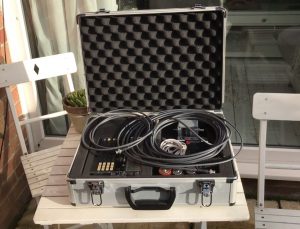
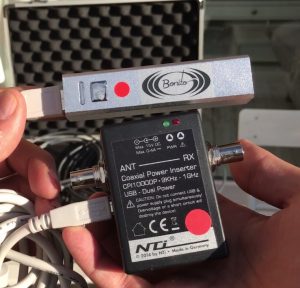 My portable Dxing kit with MA305 antenna The MA305 power inserter and USB power ‘brick’
My portable Dxing kit with MA305 antenna The MA305 power inserter and USB power ‘brick’
The specifications of the MegActive MA305 are very similar to the Boni Whip; they both offer a Gain of +3 dBs, second and third order intercept points of greater than +30 and +50 dB respectively and both tune to 300 MHz. The MA305 is supplied with a longer radiating element and tunes down to 9 KHz (versus the 20 kHz lower limit for the Boni Whip). Obviously this isn’t a specification that is going to concern most radio enthusiasts; both offer fantastically wide operating bandwidths. The way in which these antennas do differ quite significantly however, is in how they are powered. The Boni Whip operates from 12 to 15 V, whilst the MA305 operates from 5 to 15 V. Bonito’s design philosophy regarding this feature is based on the increasing difficulty in procuring reasonably priced analogue external plug-in power supplies (they are no longer allowed to be produced due to power consumption restrictions).
Interestingly, when the power supply for my Wellbrook ALA1530 packed up, I called them to purchase a replacement and was told they only have limited stocks remaining. Thus, a solution for powering active antennas with a suitable low-noise supply is an issue that needs resolving. The guys at Bonito figured a USB power source was suitably quiet and with USB ‘power bricks’ almost ubiquitous these days for charging mobile phones and other portable electronic devices on-the-go, the idea could be applied to their active antennas. The result is the MegActive MA305, designed to operate at 5 Volts with no loss of performance. As a DXer who probably spends more time listening on DXpeditions than I do in my shack at home, the USB power solution was perfect. I myself often carry a cheap Chromebook laptop to use as an additional power source for my camera phone when I’m DXing, so Bonito’s design approach resonated with me completely.
Travelling with the MegActive MA305
Ok, so the MA305 is very compact and very light indeed – perfect for a trip to Crete! However, I know from many conversations with my YouTube friends and followers that some of us feel a slight sense of trepidation carrying shortwave radios and antenna systems on board flights, be they national or international. I myself wasn’t really concerned other than if my bag got pulled from the X-ray machine, there’s often quite a long wait whilst the security staff work through the queue of luggage requiring er…human intervention! Predictably, my rucksack did get pulled and I waited patiently until it was my turn to explain the contents! Looking back on this retrospectively, it’s hardly surprising. Other than the usual holiday paraphernalia, my rucksack contained:
- A 10.0 metre length of H-155 coaxial cable
- A 1.0 metre length of H-155 coaxial cable
- Eton Satellit receiver
- MA305 Coaxial Power Inserter
- MA305 Antenna Amplifier
- Bonito USB ‘Power Brick’
- Bonito USB Power Cable
- NooElec RTL-SDR dongle
- NooElect ‘Ham It Up’ upconverter
- Various screened cables and connectors
- 10 metres of equipment wire
I explained to the (friendly) security chap that I was a shortwave radio hobbyist and identified the various pieces of equipment for him, as he removed them from my rucksack. He confirmed my X-ray had ‘lit up’ (in blue as it happens) with metallic/electronic items and was even kind enough to swivel his monitor to show me the mess of items strewn across the screen – just as I had thrown them all into my rucksack! However, after quickly swabbing some of the items, he said all was fine and hoped that I enjoyed my holiday and listening. Service with a smile at Gatwick Airport – and I was on my way. My outbound experience got me thinking whether it would be possible to pack my DXing kit in such a way that it wouldn’t alarm airport security. Thus, for the trip home, I packed all of my cables into my (checked-in) suitcase. I figured it would be obvious there was no security risk associated with cables alone. I then packed my RTL-SDR, upconverter and all of the MS305 components very neatly into a single box and put that in my carry-on rucksack. Now, some might argue that security measures at Heraklion International Airport in Crete differ a little from London Gatwick, but I observed staff at the X-ray machine very carefully monitoring every piece of luggage passing through it – including my own and I passed straight through without a problem. All I did was take my laptop out as usual, and put it in a separate tray. Job done.
DXing with the MegActive MA305
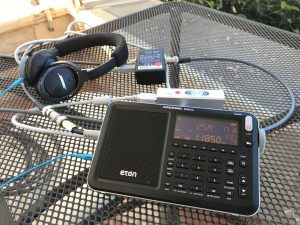 My listening post in Crete, with the brilliant Eton Satellit receiver
My listening post in Crete, with the brilliant Eton Satellit receiver
My apartment in Crete was on the second floor and a large balcony provided a decent outdoor location for DXing. As regards electrical noise, the location was much quieter than my shack at home, but it certainly wasn’t perfect, thus a good test of the MA305 in a real-world pseudo-urban environment. in an attempt to improve SNR, I bought a cheap ‘Selfie Stick’ and some tape and managed to construct a mount for the amplifier, increasing the overall height above ground by about 1.5 metres and displacing the radiating element an additional 2 metres thereabouts from the building. I’m not sure whether it made much difference, but it seemed like the sensible thing to do for less than 10 Euros.
During my week-long stay, I managed to fit in several listening sessions and copied some really excellent DX from this ultra-compact, USB-powered set up. In fact, the MA305 coupled to the Eton Satellit performed so well, I managed to copy a number of personal firsts, including CRI on 7295 kHz, via their relay in Bamako, Mali, The Voice of Beibu Radio on 5050 kHz, Nanning, XSL ‘Slot Machine’ on 6251 kHz USB, Ichihara, Japan, S32 ‘The Squeaky Wheel’ on 3828 kHz and NHK World Radio Japan, 11910 kHz. I also copied RTM Wai/Limbang FM on 11665 kHz from Kajang, Myanmar Radio on 5985 kHz and AIR Bhopal on 4810 kHz, amongst others – all of which I would certainly consider to be difficult catches in Europe. To hear them with an 18 cm antenna felt pretty special. African shortwave stations were also very well represented and I managed to copy a number of them including Radio Hargeysa on 7120 kHz, Voice of Tigray Revolution on 59150 kHz, Radio Oromiya on 6030 kHz, Radio Fana on 6110 kHz, Radio Ethiopia on 7235 kHz, Radio Sonder Grense on 3320 kHz and Radio Guinée on 9650 kHz. I expected to hear all of these stations, except for Radio Guinée, which is farther away from Crete than the UK. So, all-in-all an excellent result.
Despite hearing a lot of excellent DX whilst in Crete, there is one signal I copied, which more than any other, demonstrates the DXing credentials of the MA305 – and Eton Satellit for that matter. In the early hours of the morning (00:59 hrs UTC) I copied and recorded Radio Tarma from Peru on 4775 kHz. With a TX power of 1 kW, this is a very difficult station to hear in Western Europe, even with a longwire. To catch this station in Crete, at all, was incredible on an ultra-compact set-up. It was at this point during the trip that I realised E-field antennas really do work superbly well for hard-core DXers on the move. It inspired me to conduct further tests back home in the Oxfordshire countryside, where electrical noise is absent. This I did a few days ago, with some quite amazing results on the Tropical Band. More on that to come in my next post. In the meantime, please find text links and embedded videos for selected reception recordings, below. Many more recordings are available on the Oxford Shortwave Log YouTube channel and please don’t hesitate to contact me if you require further information on the MA305 or the Eton Satellit. Thanks for reading/watching/listening and I wish you all excellent DX.
Personal firsts
Click here to view on Oxford Shortwave Log
Click here to view on Oxford Shortwave Log
Click here to view on Oxford Shortwave Log
Click here to view on Oxford Shortwave Log
Click here to view on Oxford Shortwave Log
Radio Tarma, Peru, 4775 kHz
Click here to view on Oxford Shortwave Log
Other notable catches
Click here to watch on Oxford Shortwave Log
Click here to watch on Oxford Shortwave Log
Click here to watch on Oxford Shortwave Log
Click here to watch on Oxford Shortwave Log
Clint Gouveia is the author of this post and a regular contributor to the SWLing Post. Clint actively publishes videos of his shortwave radio excursions on his YouTube channel: Oxford Shortwave Log. Clint is based in Oxfordshire, England.
Carl Laufer of RTL-SDR.com on HamRadioNow
(Source: Southgate ARC)
Carl Laufer’s RTL-SDR on HamRadioNow
Carl Laufer isn’t a ham (yet), but he got caught up in the RTL-SDR craze in his home town, Auckland NZ, as he was completing his PHD
He began writing about them, and selling them, on his blog at www.RTL-SDR.com, and soon discovered that the little SDR receiver dongles could stand some improvement.
So he designed ways to make them work better, and contracted a Chinese manufacturer to build them with his mods. That just about doubled the price, from $10 to about $20. Yeah, big deal.
TAPR invited Carl to come to the 2017 Dayton Hamvention to talk about them at both their Friday Forum (part of HamRadioNow Episode 324) and as the main speaker at the TAPR/AMSAT Banquet.
And we got him for a conversation with HamRadioNow’s KN4AQ and PhasingLine’s Chicken With Fries in the SIB back in Tent City.
Watch HRN 328: Carl Laufer’s RTL-SDR on HamRadioNow:
Click here to watch on YouTube.
I got to meet Carl at the Hamvention this year–what a great guy and his website is certainly the best source of information about the RTL-SDR.
I should note that I also met with contributor, Mike Ladd, in person at the Hamvention. Mike now works for SDRplay.
This is one of the great things about gatherings like the Hamvention–it brings together so many people that you’d otherwise likely never meet in person!
NASA’s ionospheric experiment tonight and remembering The Woodpecker Project
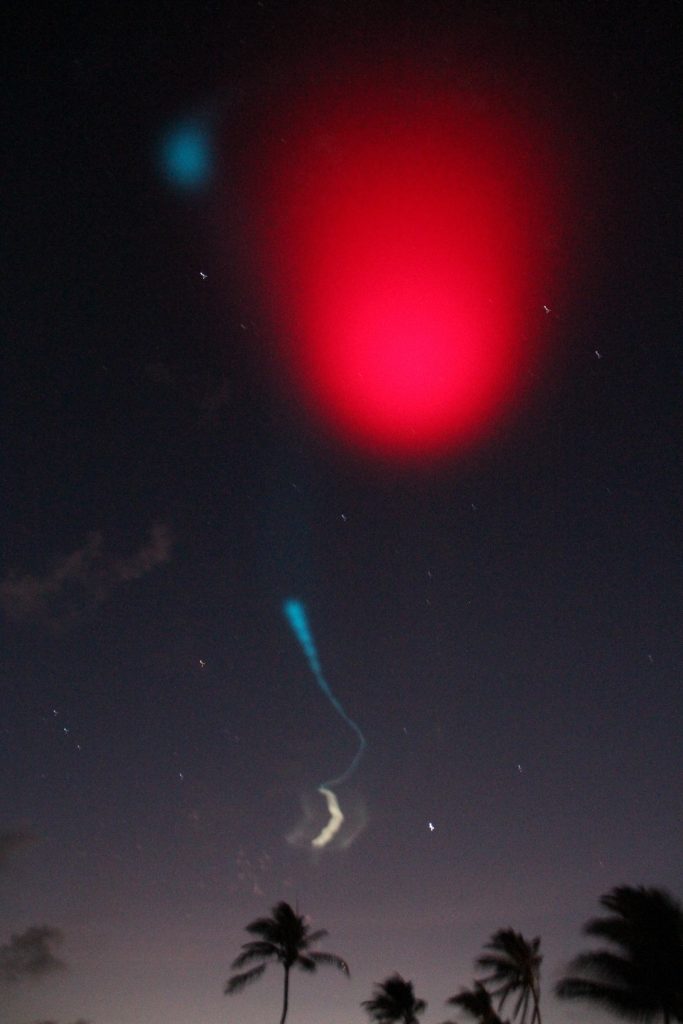
The gas mixtures from NASA’s ionospheric experiment cause parts of the night sky to glow blue and green. (Photo: NASA)
Many thanks to SWLing Post contributor, Ed, who writes:
It might be interesting if you invited SWLing Post readers today see how NASA’s ionospheric experiment tonight (shortly after 9:00PM ET) affects RF propagation along the east coast:
I searched online to find any reference to this long series of NASA experiments affecting RF propagation, and found this 1980 paper:
https://ntrs.nasa.gov/archive/nasa/casi.ntrs.nasa.gov/19810005401.pdf
…which contains this paragraph:
Ionospheric Modifications
The objectives motivating various experiments based on either decreasing or increasing the ambient plasma density by means of a chemical release include: (a) obtaining measurements of the rate of refilling after creation of a plasma depletion “hole” as a means of studying ambient ionization processes, (b) studying the magnetic field aligned propagation of VLF waves by creating a propagation duct, (c) simulating the formation and movement of the natural depletion “bubbles” which occur over the magnetic equator, (d) investigations of reaction rates, recombination coefficients, airglow production, etc., and (e) creating the conditions for inducing selected plasma instabilities to produce ionospheric irregularities and spread-F conditions. The science objectives in these experiments have a direct bearing on communication problems. Other forms of ionospheric modification are directed toward studying ionospheric/magnetospheric coupling and testing plasma theories.
So it might be fun to crowdsource from the SWL community to see if we can detect any propagation anomalies Tuesday night during this brief experiment. It’s unfortunate there’s not more time to coordinate different listeners monitoring different assigned frequencies. This reminds me of participating in ANARC’s “Woodpecker Project” in 1985 with 95 other SWL’s in 18 countries to determine the interference effects on HF broadcast from the Soviet Union’s use of Over-The-Horizon (OTH) radar in the HF bands.
I wonder how many SWL’ing Post readers participated in The Woodpecker Project and still have the nice “No Woodpeckers” tee shirt they earned for submitting their findings, which were combined into a final report that condemned the Soviets for causing interference on the HF bands.
Thanks for the tip, Ed! According to the linked article, the experiment will take place this evening, “soon after nine o’clock eastern time” (or 01:00 UTC).
This would be a great time to do an SDR wideband spectrum recording since you could possibly see any propagation effects on the waterfall display and play the event over multiple times. I’ve no clue if this experiment would yield any discernable results on HF, but it would be fun trying to detect it nonetheless.
Please comment if you plan to check out the experiment and/or if you were a participant in the Woodpecker Project!
2017 Hamvention photos: Saturday Flea Market
While looking through photos I had backed up on my laptop, I discovered a set I took at the Hamvention Flea Market on Saturday morning (May 20, 2017). I’ve gotten tremendous positive feedback from the photos I posted of Hamvention Setup, the Friday Flea Market and Inside Exhibits, so I thought I’d post these as well.
Below, you’ll find 84 additional flea market photos. Click on the thumbnail to expand each photo. I’ve tried to include price tags when possible. I’m sure some of these items are also featured in my Friday flea market photo album. Enjoy:
Radio Erena “provides a voice for the voiceless”
(Source: Open Democracy)
Eritrean radio station Radio Erena provides a voice for the voiceless
Broadcasting from Paris, Fathi Osman’s Radio Erena challenges the government’s monopoly on truth and champions those who gave their lives for freedom of expression.
Last night turned out to mark a double-celebration for Eritrean journalist Fathi Osman. While the father-of-four nearly let his 51st birthday slip by unnoticed, he certainly couldn’t play down his radio station’s spectacular win at One World Media Awards in London’s BAFTA building.
Radio Erena (‘Our Eritrea’) broadcasts from Paris, where Fathi now lives with his wife and children, having fled the dictatorship five years ago. The station was founded in 2009 by the well-known exiled Eritrean journalist Biniam Simon, with support from Reporters Without Borders. The goal? To offer a lifeline of independent news, information and entertainment for Eritreans both in their homeland and worldwide.
As Fathi held out his hand to shake mine, he noticed his fingers were stained inky blue. “Ah, you can tell I’m a writer,” he observed with a smile. Currently Radio Erena’s Assistant Project Manager, in the past Fathi worked variously as a journalist and diplomat before he left the Eritrean embassy in Riyadh to seek safety in France. “I had developed ideas that the government did not accept,” he explained, “and you know, with these kinds of conflicts, in the end you will meet trouble.”
Fathi’s family was among more than 4,000 Eritreans who flee each month. And is it any wonder, given the UN June 2016 report that the regime has been responsible for crimes against humanity since 1991? Known globally as a predator of press freedom, President Isaias Afewerki has led Eritrea to be ranked consistently as the very lowest of 180 countries in Reporters Without Borders’ World Press Freedom Index, though in 2017 the regime came second-last as North Korea deteriorated even further.
Afewerki’s purges in September 2001 ended Eritrea’s free press – by now, seven of the 11 journalists arrested at that point have died in detention. This year at least 15 journalists are believed to be detained without charge or trial. Dawit Isaak, a Swedish-Eritrean citizen who had returned to Eritrea to open Setit – the first independent newspaper there, has not once talked to a lawyer in 16 years of imprisonment. His fate is unclear.
Far from having deterred the four journalists based in Radio Erena’s newsroom (as well as their 25 or so correspondents worldwide), these appalling abuses have driven them to pour every effort into remedying the crackdown. The station broadcasts in Tigrinya and Arabic by satellite and short wave – and is available online or via a mobile phone app.
“Within the whole of Eritrea there’s only one radio station, one newspaper,” Fathi explained. “That means the ‘truth’ is dominated by the government. Radio Erena is working to counter that. We do everything, from exposing news that the government doesn’t want people to know, to hosting shows for singers and writers – and raising awareness of human rights is very important to us.”[…]
Continue reading the full article on Open Democracy’s website.
Note: Radio Erena can be heard on 11,965 kHz between 1700-1800 UTC. They broadcast from Kostinbrod in Sofia, Bulgaria with 50 KW.
From the Isle of Music and Uncle Bill’s Melting Pot, June 11-17
From the Isle of Music, June 11-17
This week our special guest is Giraldo Piloto, leader of Klimax, one of Cuba’s best Timba bands. Klimax won a Cubadisco award this year in the category Música Popular Bailable -Maestros for its album Mis 21 Años. We will listen to some of that album as we speak with Giraldo, who granted us an interview in his home. We will also taste a little of Dayme Arocena’s album Cubafónia.
Four opportunities to listen on shortwave:
1. For Eastern Europe but audible well beyond the target area in all directions with 100Kw, Sunday 1500-1600 UTC on SpaceLine, 9400 KHz, from Kostinbrod, Bulgaria (1800-1900 MSK)
2. For the Americas and parts of Europe, Tuesday 0000-0100 UTC on WBCQ, 7490 KHz from Monticello, ME, USA (Monday 8-9PM EDT in the US)
3 & 4. For Europe and sometimes beyond, Tuesday 1900-2000 UTC and Saturday 1200-1300 on Channel 292, 6070 KHz from Rohrbach, Germany.
From the Isle of Music is not available for listening on demand but some broadcasts can be heard online during the time of the broadcast using Web SDRs or the WBCQ website (during their broadcast) if you are not receiving the radio signal.
Episode 16 of Uncle Bill’s Melting Pot, a musical variety program that features everything from everywhere EXCEPT music that you are probably familiar with, will air on WBCQ the Planet, 7490 KHz, Thursday,June 15 from 2300-2330 UTC (7:00pm-7:30pm EDT in the Americas). We’ll spend half the program in Mexico to honor XERMX, the wonderful and long-gone shortwave station from Mexico City that we listened to in the 70s. Brought to you by Tilford Productions, which also brings you From the Isle of Music.



